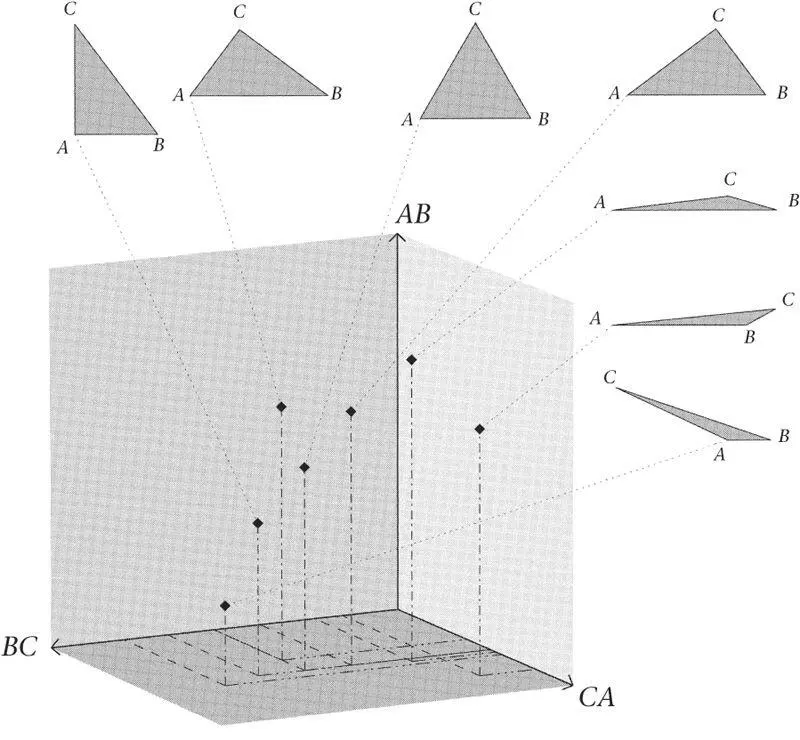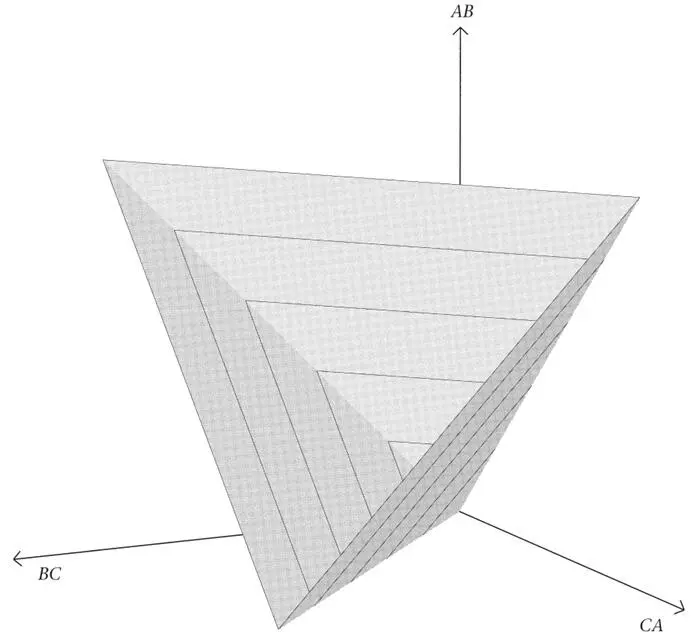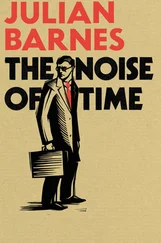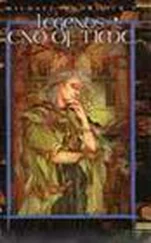I have gone to some trouble to describe Triangle Land because it can be used to model the totality of possible Nows. Like real countries, and unlike absolute space, which extends to infinity in all directions, it has frontiers. There are the sheets, ribs and apex of Figure 4. They are there by logical necessity. If Nows were as simple as triangles, the pyramid in Figure 4 could be seen as a model of eternity, for one notion of eternity is surely that it is simply all the Nows that can be, laid out before us so that we can survey them all.

Figure 3.The seven triangles represent several possible arrangements of a model universe of three particles A, B, C. Each triangle is a possible Now. Each Now is associated with a point (black diamond) in the ‘room’ formed by the three grid axes AB, BC, CA, which meet at the corner of the ‘room’ farthest from you. The black diamond that represents a given triangle ABC is situated where the distance to the ‘floor’ is the length of the side AB (measured along the vertical axis), and the distances to the two ‘walls’ are equal to the other two sides, BC and CA. The dash-dotted lines show the grid coordinates. In this way, each model Now is associated with a unique point in the ‘room’. As explained in the text, if you ‘touched’ one of the black diamonds, the corresponding triangle would light up. However, not every point in the ‘room’ corresponds to a possible triangle – see Figure 4.
A three-particle model universe is, of course, unrealistic, but it conveys the idea. In a universe of four particles, the Nows are tetrahedrons. Whatever the number of particles, they form some structure, a configuration . Plastic balls joined by struts to form a rigid structure are often used to model molecules, including macromolecules such as DNA, which are ‘megamolecules’. You can move such a structure around without changing its shape. For any chosen number of balls, many different structures can be formed. That is how I should like you to think about the instants of time. Each Now is a structure.

Figure 4.This shows the same ‘room’ and axes as in Figure 3, but without the walls shaded. Something more important is illustrated here. In any triangle, no one side can be longer than the sum of the other two. Therefore, points in the ‘room’ in Figure 3 for which one coordinate is larger than the sum of the other two do not correspond to possible triangles. All triangles must have coordinates inside the ‘sheets’ spanned between the three ‘ribs’ that run (towards you) at 45° between the three pairs of axes AB, BC (up to the left), AB, CA (up to the right) and BC, CA (along the ‘floor’, almost towards you). Points outside the sheets do not correspond to possible triangles. However, points on the sheets, the ribs and the apex of the pyramid formed by them correspond to special triangles. If vertex A in the thin triangle at the bottom right of Figure 3 is moved until it lies on BC, the triangle becomes a line, which is still just a triangle, because BC is now equal to (but not greater than) the sum of CA and AB. Such a triangle is represented by a point on one of the ‘sheets’ in Figure 4. If point A is then moved, say, towards 8, the point representing the corresponding triangle in Figure 4 moves along the ‘sheet’ to the corresponding ‘rib’, which represents the even more special ‘triangles’ for which two points coincide. Finally, the apex, where the three ribs meet in the far corner of the ‘room’, corresponds to the unique and most special case in which all three particles coincide. Thus, Triangle Land has a ‘shape’ which arises from the rules that triangles must satisfy. The unique point at which the three particles coincide I call Alpha.
For each definite collection of structures – triangles, tetrahedrons, molecules, megamolecules – there is a corresponding ‘country’ whose points correspond to them. The points are the possible configurations. Each configuration is a possible thing; it is also a possible Now. Unfortunately it is impossible to form any sort of picture of even Tetrahedron Land: unlike Triangle Land, which has three dimensions, it has six dimensions. For megamolecules, one needs a huge number of dimensions. In Tetrahedron Land you could ‘move about’ in its six dimensions. As in my earlier example, the way to think about its individual points is that if you were to touch any one of them, a picture of the tetrahedron to which it corresponds would ‘light up’. In any Megamolecule Land, with its vast number of dimensions, ‘touching a point’ would cause the corresponding megamolecule to ‘light up’. The more complicated the structures, the greater the number of dimensions of the ‘land’ that represents them. However, the structures that ‘light up’ are themselves always three-dimensional.
You do not need to try to imagine these much larger spaces – Triangle Land will do. I hope you do not find it a dull structure or too hard to grasp. It is, in fact, an example of a very basic notion in physics called a configuration space that is normally regarded as too abstract to attempt to explain in books for non-scientists. But I cannot begin to get across to you my vision of a timeless universe without this concept. If you can get your mind round this concept – and I do encourage you to try – you will certainly understand a lot of my book. The notion of configuration space opens up a wonderfully clear way to picture, all at once, everything that can possibly be.
It will also give us new notions of time and history, stripping away and revealing as redundant the Newtonian superstructure. The observable history of a three-particle universe, when the invisible absolute space and time are abstracted away, is just a continuous sequence of triangles. Suppose we are given such a history. We can then mark, or plot, the points in Triangle Land that correspond to the triangles. We shall obtain a curve that winds around within the pyramid in Figure 4. In this new picture, history is not something that happens in time but a path through a landscape. A path is just a continuous track of points in a land. In this book I use the word path very often in the generalized sense of a continuous series of configurations taken by some system (consisting, usually, of material points). Understood in this sense, paths are possible histories. There is no time in this picture.
Paths highlight the dilemma brought to light by Boltzmann’s work. On any path, you can call the point where you stand Now. But you can walk along a path in either direction. There is nothing in the notion of a path that can somehow make it a one-way street. You can also see that the notion of a moving present may be redundant. You might try to represent it by a spot of light moving along the path, making each successive point on the path into the present Now, and therefore more real than the ‘past’, through which the spot has already passed, and the ‘future’, which the spot has not yet reached. But if, as I have suggested, all our conscious experiences have their origin in real structure within the Nows, we can do without the fiction of the moving present. The sense we have that time has advanced to the present Now is simply our awareness of being in that Now. Different Nows give rise to different experiences, and hence to the impression that the time in them is different.
I need a name for the land of Nows. Plato, who lived about a century after Heraclitus and Parmenides, taught that the only real things are forms or ideas : perfect paradigms, existing in a timeless realm. In our mortal existence we catch only fleeting glimpses of these ideal forms. Now each point – each thing – in these ‘countries’ I have asked you to imagine could be regarded as a Platonic form. Triangles certainly are. I shall call the corresponding ‘country’ Platonia . The name reflects its mathematical perfection and timeless landscape. Nothing changes in Platonia. Its points are all the instants of time, all the Nows; they are simply there, given once and for all.
Читать дальше














